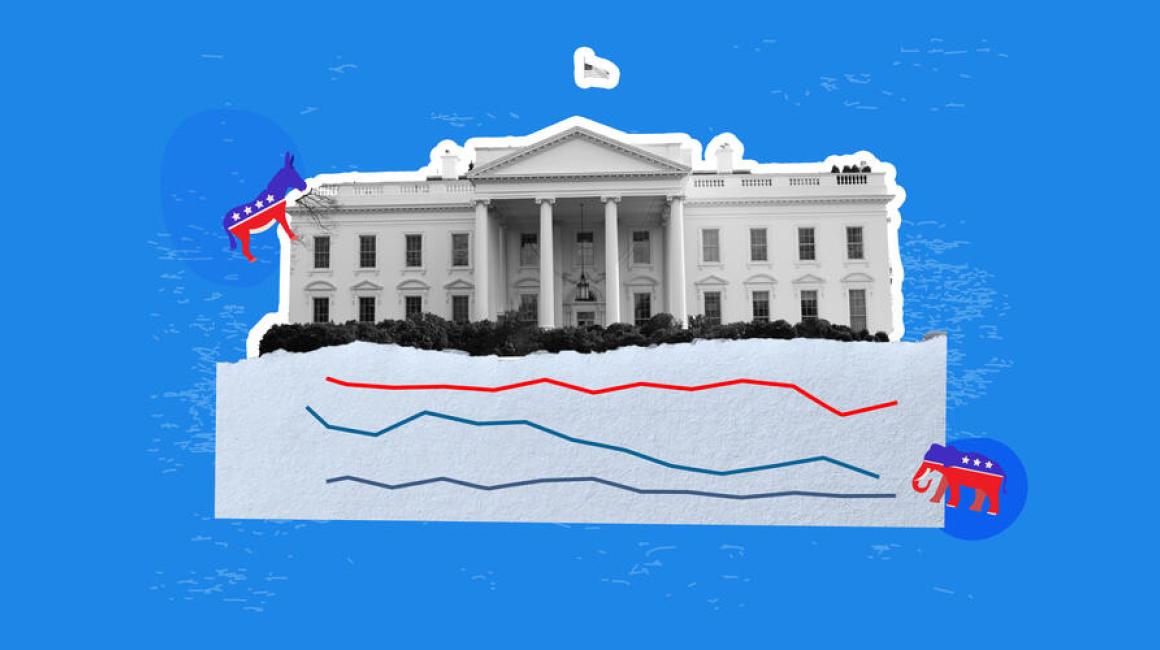
Gas prices are rising. No inflation relief is in sight. The pandemic is now in its third year. And there’s an international war. All while the U.S. political system continues to be politically polarized.
It’s a tough time to be a world leader. And the current U.S. presidential approval ratings like Gallup and Marist Poll — which act as a barometer into the political health of the president — echo this. Among post-World War II presidents elected to their first term,nearly all first-year presidents averaged 57% or better. But President Joe Biden’s recent Gallup low of 41% puts him near the bottom.
But is a failing grade deserved?

Political Science Associate Professor Julio Borquez, whose polling research spans 40 years, says it depends on who’s asked. His expert take? Biden got caught at the crossroads of unfortunate circumstances and unrealistic expectations.
“Biden’s approval ratings are following a pattern similar to what we’ve seen in recent presidencies. He began with a decent (Gallup) approval rating of 57%, and it has dropped in the year or so since down to its current 41%. The decline began last summer, and it can probably be pegged to inflation, the withdrawal from Afghanistan, the emergence of Omicron and a stalled legislative agenda.” Of course there’s also the “record high” gas prices — but, to be fair to Biden, gas prices were 32% higher in 2008 under President George W. Bush if inflation is taken into account.
Talking with Borquez recently, he examined how political polarization impacts the presidential approval rating, what a low approval percentage could mean at the midterm elections, and if there is anything Biden can do to appeal to the American public.
There’s been a bump in recent numbers (48% on March 4) according to the Marist Poll. What are your thoughts on this?
Julio Borquez: “JFK got a spike in his approval rating around the time of the Cuban missile crisis. (Jimmy) Carter got one when hostages were first taken in Iran. George W. Bush’s ratings rallied to 90% after 9/11. Approval ratings can increase, sometimes dramatically, immediately after foreign policy crises.
It may be from the State of the Union, but it’s more likely that Joe Biden is getting a bump from the public giving him the benefit of the doubt on how he’s handling the conflict in Ukraine. It’s a small bump — I wouldn’t call it a rally. We’ll see what the future brings because approval ratings often suffer as wars continue and casualties mount.”
Do these approval numbers matter?
“Lots of people take it seriously as a barometer. That includes members of Congress, journalists and lobbyists. The real danger in Biden's current approval rating is for his party's candidates in the midterm election. Congressional incumbents today can’t separate themselves from national political currents as they once could. And anemic approval ratings like Biden’s are certainly an unwelcome current for Democratic congressional incumbents.
In general, an approval rating over 50% is considered good and approval ratings below 50% are considered to be concerning. In 2018, Donald Trump's approval rating in the Gallup poll before the midterm election was in the low 40s. Republicans lost 40 House seats and the majority. In 2010, Barack Obama's approval rating had dipped to 45%. Democrats lost 63 seats and the majority. In 1994, Bill Clinton's approval rating was 46%. Democrats lost 53 seats and the majority. You get the picture. George W. Bush’s approval ratings were over 60% throughout the fall of 2002, and the Republicans gained two Senate seats and eight House seats.
Biden’s approval rating of 41% might not have his staff hitting the panic button, but they’ve probably double-checked on where the button is.”
Is it fair to be so critical of Joe Biden?
“In Biden’s case, he encouraged high expectations. He was optimistic about reigning in the pandemic, he advanced an ambitious policy agenda on infrastructure, climate, jobs, election reform and voting rights. Many Americans perhaps do expect too much from presidents — but Biden asked us to expect a lot.”
He’s getting blamed for rising gas prices. Is that warranted?
“I’ve recently returned from California and have seen our future when it comes to gas prices — $5.59 a gallon in Oakland. That’s not going to go over well for Biden. But the price of gas is not something a president can control or quickly fix outside of reducing or suspending the federal tax on it — that will only have a limited effect (taxes on gasoline and diesel are 18.4 and 24.4 cents per gallon respectively). I get why people are upset — it’s something we are seeing on Main Street and it’s impacting our lives. But we need to understand that Biden cannot control all of the external factors behind the record high oil prices, he can only react to them.
Joe Biden has done good things. The infrastructure bill that he signed into law back in November comes to mind. But tangible results of that bill will be slow to roll out — specific spending decisions are yet to be made and the projects themselves will play out over months, if not years. It’s no accident that when Biden made a recent trip to Ohio, one of his tasks was to remind voters about the infrastructure bill.”
Is there more at play here than Biden setting high expectations?
“Going back to the 2020 elections, it was evident that a lot of Biden voters weren’t wildly enthusiastic about him and they voted for Biden because he wasn’t Donald Trump. The erosion of support for Biden we’re seeing now among Democrats and Independents might be among those citizens who were motivated more by dislike of Trump than by admiration of Biden.
In recent years, as American politics has become more polarized, many analysts now see presidential approval as primarily a measure of partisanship. Obama’s approval ratings didn’t change much with fluctuations in the economy. That’s because Democrats supported, and Republicans opposed him regardless. We saw the same thing with Trump’s approval ratings, except with the partisan patterns reversed.
Biden’s current Gallup overall approval rating is 41%. But if you look down party lines, it shows the division that exists — approval ratings among Republicans have never topped 12%, and they’ve been in single digits since last August. Biden’s current approval rating among Democrats is 78% and it’s 7% among Republicans. Partisan polarization creates both a floor and a ceiling for Biden’s approval ratings. Persistent Republican opposition sets the ceiling, ongoing Democratic support provides the floor. This appears to be an important new feature in presidential approval ratings. Partisan polarization sets limits to how much approval ratings can rise or fall.
A president’s ‘power to persuade’ depends, in part, on his ability to get members of Congress to think that it’s in their best interest to support the president’s agenda. A president with a robust approval rating — say, over 50% — can more easily make that case. Biden’s 41% rating isn’t much of an asset. Realistically, there’s not much he can do to drastically change it because of the partisan patterns that exist.”
If our leaders are relatively ineffective because of political polarization, what can we do?
“Use your vote to demand that both parties take a responsible role in government. Currently, in Congress, Republicans are sitting on the sideline and their strategy is rock-solid opposition to most Biden-backed proposals that are brought forward. They don’t want to advance anything — so they do nothing. And Democrats are trying to grapple with disagreements among themselves because they need to maintain near unanimous Democrat support to get anything moving.
I do understand that the Build Back Better bill was massive and the size of it gave some Democrats and most Republicans an easy rationale to say no. Perhaps Congress could have done a piece-by-piece strategy and voted on it that way. The issue is that no one wants to give any appearance of a win to the other party. That’s become more important than working together to best represent the American public.
We need to put pressure on both parties to step up to the plate. At this time, only one party is really trying to do that. We need to use our votes to back politicians who will take policymaking seriously and who will work for the people and not just their party.”
Article by Sarah Tuxbury.



